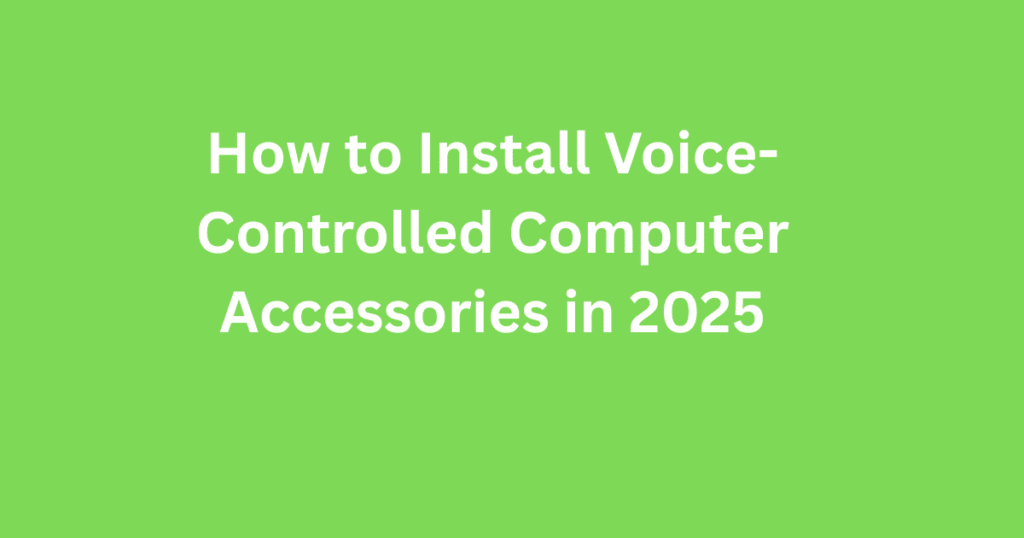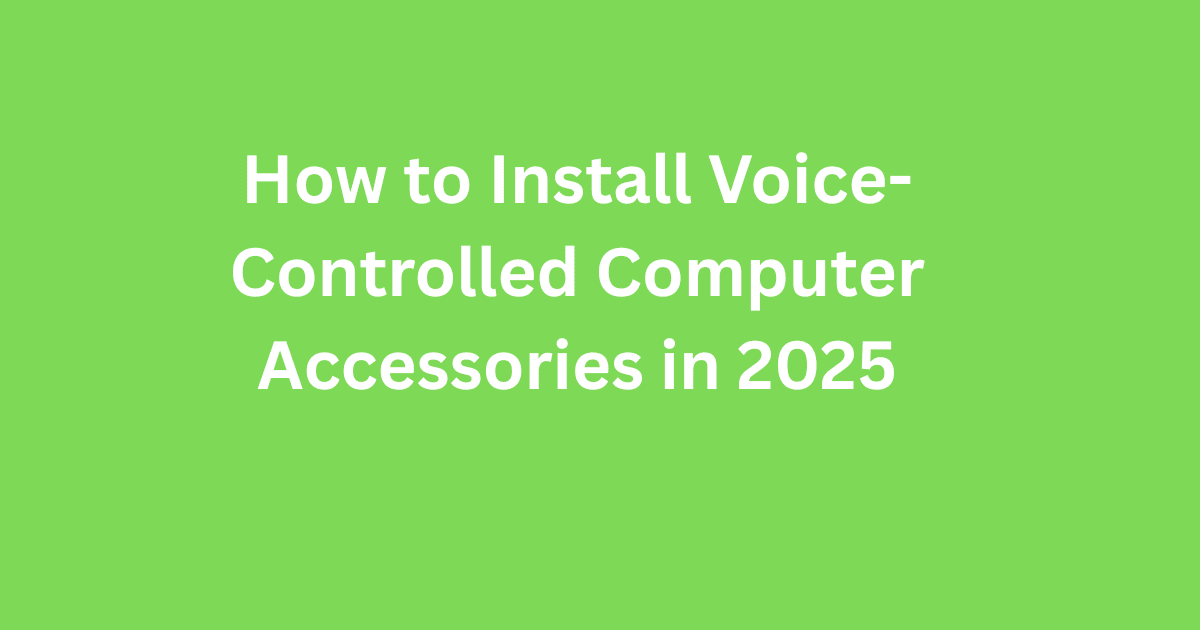Whether you’re working from home, managing a smart workspace, or just want to impress your friends, voice-controlled computer accessories are one of 2025’s biggest tech trends. From speakers and webcams to keyboards and lighting systems, everything is getting smarter—and hands-free.
But here’s the catch: most people get excited about these futuristic tools, buy them… then struggle to set them up properly.
If you’re wondering how to install voice-controlled computer accessories 2025 style—without getting stuck in confusing manuals or endless troubleshooting—you’re in the right place.

What Are Voice-Controlled Computer Accessories?
Voice-controlled accessories are external devices that respond to your voice commands. Instead of using a mouse or keyboard, you can just speak to perform tasks like:
- Turning on/off the lights
- Controlling music or volume
- Starting a webcam or screen recording
- Launching software
- Adjusting brightness or typing using speech-to-text
Popular examples in 2025 include:
- Smart speakers with AI assistants (like Alexa, Siri, Cortana 2.0)
- Voice-enabled webcams
- Microphones with built-in voice controls
- RGB lights synced with voice commands
- Hands-free headphones
- Voice-to-text ergonomic keyboards
Why Voice-Controlled Accessories Are Trending in 2025
Let’s be real: touch is great, but hands-free is better when you’re multitasking or want to work faster.
Here’s why these accessories are hot right now:
- Boost productivity
- Improve accessibility for disabled users
- Enhance the smart home/office experience
- Reduce wear and tear on hardware
- Just plain cool to use (and fun too)
How to Install Voice-Controlled Computer Accessories in 2025 (Step-by-Step)
1. Check Compatibility Before Buying
Before installation, make sure your device supports:
- Windows 11 or macOS Ventura and above
- Bluetooth 5.3 or USB-C for modern connection standards
- AI assistant integration (Alexa, Siri, Google, Cortana)
- Voice recognition software (most come with it pre-installed in 2025)
💡 Pro Tip: Many 2025 accessories now use universal voice assistant support, so you don’t have to worry about being locked into one platform.
2. Unbox and Inspect the Hardware
Don’t skip the basics:
- Open the box carefully
- Look for any signs of damage
- Check if it includes user guides, adapters, and extra cords
- Register your device online for warranty
3. Power Up and Charge (If Wireless)
If you’re using wireless gear like a voice-activated headset or mic:
- Fully charge it first
- Use the original cable for best charging speed
- Avoid using it while charging (can mess up performance calibration)
Want better battery life? Here’s a guide on how to fast better battery life time to get the most from your gadgets.
4. Connect the Device (Wired or Wireless)
Here’s how you connect most accessories:
🖥️ For Wired Devices
- Plug into a USB-C or USB-A port
- Wait for auto-installation
- Open “Device Manager” to confirm detection
📡 For Wireless Devices
- Enable Bluetooth or Wi-Fi
- Go to Settings > Bluetooth > Pair New Device
- Select your accessory and click Connect
Some smart accessories also use NFC pairing—just tap your phone to them!
5. Install the Companion Software or App
Most voice-controlled accessories come with companion software. Here’s what to do:
- Visit the brand’s official site (NEVER download from third-party sites)
- Download the latest version of their setup utility or control center
- Run the installer
- Follow on-screen steps to finish installation
These apps allow you to:
- Train the voice recognition software
- Assign voice commands to specific actions
- Customize features like LED lighting or shortcuts
6. Sync With a Voice Assistant
2025 devices typically support at least one voice assistant. Choose yours:
- Alexa: Best for home integration
- Google Assistant: Great for Android users
- Siri: Best for Mac users
- Cortana (2025 version): More focused on productivity
Here’s how to link
- Open the companion app
- Go to Voice Assistant Settings
- Choose your assistant and follow the pairing instructions
- Grant permissions for mic access and control
7. Set Up Voice Commands
Here’s where it gets fun. Assign voice commands to tasks like:
- “Turn on my webcam”
- “Start screen recording”
- “Lower brightness to 50%”
- “Open Chrome”
- “Mute audio”
Some accessories even allow custom wake words, so instead of saying “Hey Google,” you could say “Yo System!”
8. Calibrate Voice Sensitivity
Nothing’s worse than yelling at a device that doesn’t listen.
So make sure to calibrate:
- Microphone sensitivity
- Wake word recognition
- Background noise filtering
Use the settings within the device’s app. Say the same command in different tones to test consistency.
9. Test Each Function Thoroughly
Run a full test before relying on the setup:
- Speak commands naturally
- Try using the accessory from different angles or distances
- Check for response lag
- Test commands in low and high-noise environments
If something seems off, restart the accessory or update its firmware.
10. Enable Smart Automation (Bonus)
2025 gadgets allow you to create “scenes” or “macros.”
For example:
- Say “Start Work Mode” to turn on lights, open your calendar, and start ambient music.
- Say “Focus Mode” to mute all notifications, dim the screen, and launch your favorite focus app.
You can build these automations using tools like:
- IFTTT
- Apple Shortcuts
- Google Routines
- Alexa Blueprints
Advanced Tips to Improve Performance
✅ Keep Your System Clean and Fast
If your computer lags, even voice control won’t work well. Check this guide on how to speed up PC for essential performance tips.
✅ Update Firmware Regularly
Voice-controlled devices often get smarter with software updates. Check for updates every few weeks using the companion app.
✅ Use Dual-Microphone Setups
This improves clarity and range, especially for accessories like voice-recognition headsets or smart mics.
Top Voice-Controlled Accessories in 2025 (Must-Try Picks)
| Accessory | Why It Rocks |
|---|---|
| Logitech VoiceCam V5 | Auto-focus + voice-triggered streaming |
| Razer Synapse Voice RGB | Lights up on command |
| Elgato Wave 4 | AI filters + hands-free recording |
| Microsoft Halo Keyboard | Full voice typing + custom macros |
| Google Smart Mic Pro | Background noise cancelation for noisy rooms |
Real-Life Uses of Voice-Controlled Accessories
- Remote Workers: Run Zoom, Slack, and emails hands-free
- Gamers: Trigger screen recordings, mute chat, switch views
- Podcasters: Start/stop recording without touching gear
- Students: Open study tools, take voice notes, adjust lighting
- Disabled Users: Total control without physical movement
Troubleshooting Tips
Problem: Device doesn’t respond
Fix: Recalibrate voice recognition, update firmware, or reset device
Problem: Voice assistant not syncing
Fix: Re-pair with your account or check permission settings
Problem: Lag in command execution
Fix: Close background apps or restart your system
Problem: Poor mic sensitivity
Fix: Increase gain or switch to a better-quality microphone
Final Thoughts
Learning how to install voice-controlled computer accessories in 2025 is more about getting familiar with smart technology than technical skills. Once you’ve connected, calibrated, and synced your devices, you’ll wonder how you ever lived without voice control.
Whether you’re upgrading your workspace, streaming content, or just love futuristic tech—this is your time to go hands-free, stress-free, and full-on smart.
Got your accessory ready? Start talking—your gadgets are listening.
FAQs
1. What are the essential steps to install voice-controlled computer accessories?
To install voice-controlled computer accessories, first, ensure your device is compatible with voice assistants like Alexa, Google Assistant, or Siri. Then, connect the accessory (either via Bluetooth or USB), install any companion apps for the device, and sync it with your voice assistant. Finally, calibrate the voice commands for accurate recognition.
2. Do I need an internet connection for voice-controlled accessories to work?
Yes, most voice-controlled accessories require an internet connection to function. This allows them to sync with cloud-based services and access real-time data, like weather updates or smart home controls. Without internet, some features may be limited, especially those involving external integrations.
3. How do I ensure that my voice-controlled device is compatible with my computer?
Before purchasing, check the specifications of the device. Ensure it supports the latest operating system versions, like Windows 11 or macOS Ventura, and has Bluetooth or USB-C support for connection. Additionally, verify that your computer has a compatible voice assistant (Alexa, Siri, or Google Assistant) or the necessary software installed.
4. Can I use voice-controlled accessories with an older computer or operating system?
While some older computers might support basic voice commands, using newer voice-controlled accessories often requires the latest operating systems, such as Windows 11 or macOS. If you’re running an outdated OS, some features may not function properly, or certain accessories may not be recognized at all.
5. How do I train my voice-controlled accessories to understand my commands better?
To improve recognition, you’ll typically go through a setup process where you speak specific commands into the device or app. This helps the accessory learn your voice and speech patterns. If it’s struggling to understand you, make sure you’re speaking clearly and consider adjusting the mic sensitivity or using a more quiet environment.
6. What should I do if my voice-controlled accessory doesn’t respond to commands?
If your device doesn’t respond, start by checking its power connection or ensuring that it is properly paired with your computer. Try recalibrating or restarting the device. Make sure there are no software updates pending and that your internet connection is stable. If it’s still unresponsive, you may need to troubleshoot further or consult the user manual.
7. Are voice-controlled accessories secure to use, especially in terms of privacy?
Voice-controlled accessories are generally secure, but it’s important to check the privacy settings. Many devices allow you to turn off voice recording features or disable voice history. Review the privacy settings on both the accessory and the app to ensure that no unwanted data is being stored or shared with third parties.
8. Can I control multiple voice-controlled accessories at once?
Yes, most modern voice assistants, like Google Assistant or Alexa, allow you to control multiple accessories at the same time. You can set up routines or use multi-device commands, such as saying “Hey Google, start work mode” to turn on your lights, open your email, and adjust the temperature. Just ensure that all devices are synced to the same assistant.
9. What types of voice-controlled accessories are best for home offices?
For a home office, consider accessories that improve productivity and comfort. Smart speakers for hands-free control of music or calls, voice-activated webcams for video conferences, and ergonomic voice-to-text keyboards are all great options. Additionally, a voice-controlled smart light system can adjust your workspace’s lighting based on the time of day or task at hand.
10. How can I troubleshoot common issues with my voice-controlled accessories?
If you experience issues, first ensure that the device is properly connected and powered on. Reboot both your computer and the accessory, and check for any firmware or software updates. If the device is still unresponsive, reset it to factory settings or consult the manufacturer’s troubleshooting guide for more advanced solutions.
